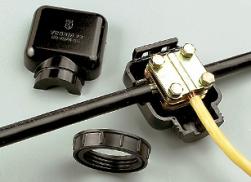Categories: Featured Articles » Electrician Secrets
Number of views: 50278
Comments on the article: 1
How to branch using branch clamps
 Branching with wires with copper or aluminum conductors from trunk lines without cutting them. For these purposes, it is most convenient to use special clamps for branching wires, the so-called "nuts".
Branching with wires with copper or aluminum conductors from trunk lines without cutting them. For these purposes, it is most convenient to use special clamps for branching wires, the so-called "nuts".
You can read about the advantages of clamps for branching wires from highways and what kind of clamps our industry produces here: Wiring Methods
In this article, we consider the technology and the sequence of work when performing a branch of conductors from a trunk without cutting them using branch clamps.
Necessary tools and fixtures: a set of screwdrivers, wire cutters, universal wiring pliers, a utility knife, wrenches, any stripping tool (I use M-1U1, but any other one can be used).
Materials - glass skin or sandpaper, trunk branching compresses.
Branch Compression Selection
In order for the branch to turn out to be high-quality and reliable, it is necessary to correctly select the branch compression. You can select the branch compression according to the table below, while you must take into account the cross section of the main and branch wires of the wires.
Table. The most common branch clamps for branching with copper and aluminum wires from trunk lines
Branch Compression Type
Cross section of wires, mm2
trunk
branch
Core preparation, installation of compression on the main wire
We determine the cross sections of the trunk and branch wires, select the connecting clamp, then remove the plastic housing of the compression and measure its contact part. We mark on the trunk and branch wires a distance equal to the contact part of the compression, plus 3-4 mm. Then we remove the insulation on the marked area with a knife, holding it at an angle to the core, so as not to accidentally damage them.
After that, we clean the exposed sections of the veins with a glass skin or sandpaper, smeared with quartz-vasilin paste, to a metallic luster. Then it is necessary to wipe the cleaned places with a dry clean cloth and immediately apply a thin layer of clean quartz-vasilin paste with a brush, evenly distributing it over the entire surface of the veins.
Then we disassemble the contact part of the compression, wipe all the parts with a cloth soaked in acetone. We look at the condition of the galvanic coating and the serviceability of each part. We install two screws in the compression from the side opposite to the branch. We install the squeeze on the main wire and "bait" the screws (bolts) with a screwdriver or wrench.
Branch branch connection and tightening of compression screws
After the compression is installed on the trunk wire, we introduce the branch of the branch wire perpendicular to the trunk into the contact part of the compression. We install the screws on the side of the branch wire onto the clamp and “bait” them with a screwdriver or wrench.
We tightly compress the conductors between the compression plates with screws using a screwdriver. To avoid skewing, it is advisable to tighten the screws diagonally gradually, in 2 - 3 steps. Then we remove the excess quartzivasiline paste. We pay attention to the reliability of the resulting electrical contact and the serviceability of spring washers under the heads of the screws (bolts).
Install plastic housing
We remove the prepress in the plastic case with the pliers, close the mounted press with two halves and tighten them with spring rings or connecting plastic nuts.
>
See also at i.electricianexp.com
:
